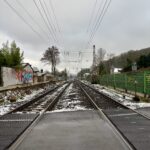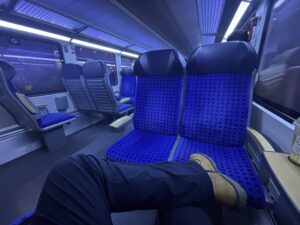Compromise: Getting Around in Germany

Introduction
Traveling around Germany has been a lesson in compromise. Without a car here, I’ve learned to embrace the highs and lows of public transportation. Efficiency, cost savings, and countless interconnected systems make it an impressive aspect of German infrastructure, but it is not quite perfect. This is what I’ve discovered so far about the trade-offs of traveling by land in Germany.
The Car-less Experience
The best piece of advice I can give from the short time I’ve been here is to “hurry up and wait.” Arriving at the train station 10 minutes early might seem excessive, but being 10 seconds late could leave you in a foul mood as you watch the train leave without you. It’s a frustrating lesson to learn.
On the other hand, if a bus is running late, your “early” arrival might turn into a 20 minute long wait in the cold winter air. I hope you brought gloves. However, there is still a silver lining: you don’t have to drive. That’s one less thing to think about, especially when navigating in an unfamiliar place.
Cost Comparison
Traveling by public transportation is both efficient and effective. According to The Motley Fool, the average American spends $179 on gas each month, roughly $2,148 annually. In contrast, Germany’s Deutschland-Ticket (D-Ticket) offers unlimited travel on local public transport for only 58 euros ($59.64) per month, or roughly $715.68 annually.
Waiting at a bus stop in winter isn’t ideal, but the savings do make it worth it. The D-Ticket allows this aspect of Germany’s public transportation system to be accessible and affordable, making it very popular with both students and local commuters alike.

Convenience
Germany’s infrastructure is a remarkable feat of interconnection. Subways and trains often share the same stations, surrounded by bus stops, sidewalks, and rental bikes or scooters. These overlapping systems make it easy to switch between modes of transportation quickly and easily.
However, a balance is crucial. If one part of the system were to fail, like a train breaking down, the remaining options would quickly become overcrowded. Each mode of transport plays a vital role in maintaining efficiency.
Part of a System
In its simplest form, transportation is just about getting people from point A to point B, yet it’s a vital aspect of any economy. Without effective ways to move people and goods around, an economy would fall apart. Germany’s well-integrated public transport ensures that people can get to work, shop for necessities and connect with each other efficiently.
Through the lens of my civil engineering class, I find it fascinating to see how Germany’s transport infrastructure supports its economy and its society as a whole. The extreme amount of planning and coordination behind these systems demonstrates the importance of interconnection within a country’s infrastructure.
Conclusion
Traveling by land in Germany offers a unique perspective on infrastructure and interconnection. While the system isn’t perfect—with delays being a common frustration—it remains an excellent example of modern engineering. Its efficiency, affordability, and integration highlight the impressive development behind it.
Sources:
The Motley Fool – https://www.fool.com/money/research/gas-prices
Deutsche Bahn – https://int.bahn.de/en/offers/regional/deutschland-ticket
Written by Brendan G

As an American, I feel we are spoiled, we rush all day long to wait! There is especially a lot to see.
are the people there in Germany friendly ?
Yes, everyone I have met so far has been very friendly! Most people keep to themselves, but if you ask them for directions or anything like that, they do not hesitate to help.